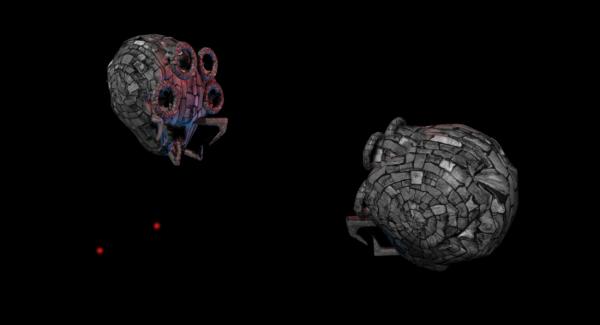BY LETTER
Empire of Screaming Skulls, The
A distant xenosophont civilisation observed only by telescope | |
 Image from Steve Bowers | |
| The 'Skulls' often orbit in pairs, apparently facing each other and oriented similarly | |
Location: NGC 7014
This elliptical galaxy is in Indus, a member of the Pavo-Indus Supercluster. At 210 million light years, NGC 7014 is too distant to allow the direct imaging of human-sized objects; nevertheless some clues about the shape and characteristics of one group of xenosophonts can be surmised from the distinctive shape of their habitats. One sector of the galaxy contains a number of systems which had been colonised by this civilisation, which appears to have been almost exclusively based in microgravity habitats rather than on planets or in rotating megastructures. Presumably the unknown xenosophonts had adapted to space-dwelling at an early stage in their development; by the time they were first observed, their empire was approximately one thousand light-years across but was expanding very slowly. The slow expansion of this empire suggests that they had already been in existence for many tens of thousands of years by this time, possibly more.
The Skull Habitats
The most notable feature of this civilisation was the shape of the habitats. Almost every habitat took a standard organic form, resembling a four-eyed skull with prominent mandibles; this had given the empire its informal name of 'The Empire of Screaming Skulls'. These habitats are often arranged in pairs, or in clusters, with the 'eye-sockets' facing inwards towards the mutual barycentre. Many xenobiologists consider that these structures are modelled on the defleshed skull of an individual of this species - however others think that this form represents a cephalothorax, or even the entire shell or exoskeleteon of an individual. In one interpretation the four 'eye-sockets' are in fact the point of attachment for four limbs or tentacles, and the 'bottom' of the 'skull' represents the head or anterior part of the organism.A small but significant number of xenobiologists think that these objects do not represent the inhabitants at all, but instead depict a different organism (or part of an organism) which the alien species enters on a habitual basis, as scavengers or parasites. Perhaps they adopt the empty shells of this hypothetical species as homes or hiding-places, like hermit crabs.
When this civilisation was first observed during the Integration many interstellar spacecraft associated with the habitats were also observed. Almost all of these were propelled by a kind of momentum-transfer beam, allowing the craft to reach one twentieth of light-speed. On several occasions observers also noted the destruction of one or more pairs of skull-habitats by projectiles powered by these beams. At this distance the projectiles appeared to have been identical with the interstellar craft, and may in fact have been so; sometimes a small fleet of interstellar craft would traverse the distance between the stars and fail to decelerate on arrival, impacting a number of habitats and destroying them (or being destroyed by momentum beams as they approached the target system). This civilisation seems to have been warlike at this time, unless these acts of destruction were some kind of ritual or competitive behaviour.
The Skull-habitat civilisation does not seem to have included any large computronium megastructures, and did not display any evidence of transapient-level technology. If there were any advanced AI entities associated with this civilisation they seem to have had little or no influence on its technology or behavior.
The Final War
By the Age of Separate Empires the destructive behaviour of these xenosophonts seems to have become more prevalent; a new faction seems to have emerged, one which inhabited smaller, more spherical structures with few skull-like features. This faction also developed much more powerful momentum-beams, which seem to have been largely used as weapons. But the new faction was greatly outnumbered. By the dawn of the Current Era most of the skull habitats and their more utilitarian counterparts had been destroyed, apparently in a long, slow war of attrition.A small but significant minority of xenologists think that this civilisation may have ascended or transcended in one of several ways, and the observed destruction was part of that process; but to date no evidence of transcension has been observed.
Related Articles
Appears in Topics
Development Notes
Text by Steve Bowers
Initially published on 09 August 2018.
Initially published on 09 August 2018.






